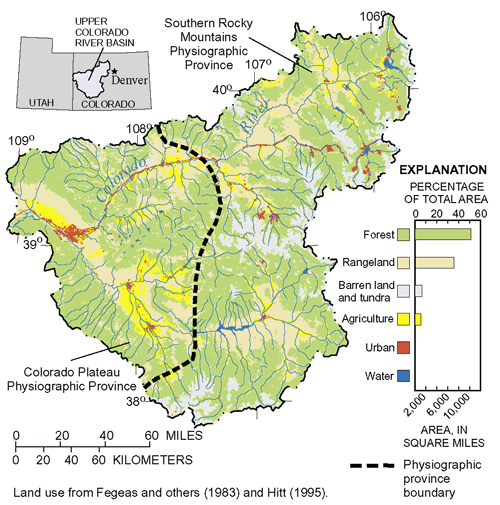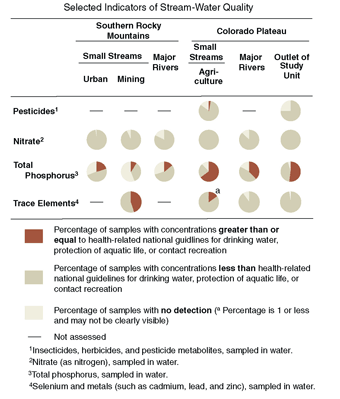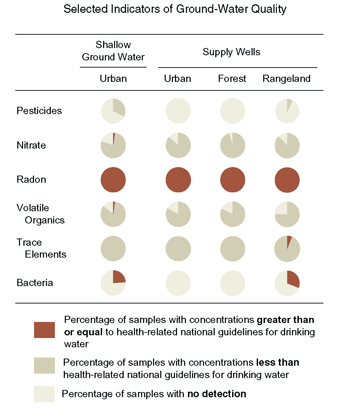SUMMARY OF MAJOR FINDINGS
 |
| The Upper Colorado River Basin (UCOL) of the National Water-Quality Assessment (NAWQA) Program includes the 17,800-square-mile drainage basin of the Colorado River upstream from the Colorado-Utah State line. The study area is almost equally divided between the Southern Rocky Mountains and the Colorado Plateau Physiographic Provinces. Population in the basin is approximately 308,000. The major use of water is irrigation, but transmountain diversions provide water to more than 1 million people in the eastern part of Colorado (outside of the study area). |
Streams and rivers in the Upper Colorado River Basin (UCOL) are very different in the two major physiographic provinces. In general, streams within the Southern Rocky Mountains are characterized by lower sediment and dissolved-solids concentrations, cooler temperatures, and somewhat higher gradients than streams in the Colorado Plateau. Sediment, salinity, and nutrient (nitrogen and phosphorus) concentrations increase along the major rivers as the water flows from the upstream areas in the Southern Rocky Mountains down through the Colorado Plateau.
Coupled with the general differences due to physiography and geology are the effects of different land uses. Recreation and urban development are becoming major land-use issues throughout the basin, precious metal mining was historically prevalent in the Southern Rocky Mountains, and intensive agriculture is located in the valleys of the Colorado Plateau.
Most of the streams and rivers sampled within the UCOL met State and Federal water-quality guidelines. Major exceptions to this statement were trace-element concentrations in some streams in the Southern Rocky Mountains and selenium concentrations in some streams in the Colorado Plateau.
- In the Southern Rocky Mountains, concentrations of nutrients (nitrogen and phosphorus) were generally low but were greater in urban streams than in streams in areas with minimal development (p. 6).
- Urban streams in the Southern Rocky Mountains had greater amounts of algae and a change in the invertebrate community from pollution-sensitive insects to pollution-tolerant insects compared to streams in areas with minimal development (p. 6–7). Similarly, in some mining areas of the Southern Rocky Mountains, the invertebrate community was also composed of pollution-tolerant insects, indicating more degraded sites (p. 13).
- Concentrations of trace elements, such as cadmium, zinc, copper, and lead, in streambed sediments in many historical mining areas were greater than guidelines for the protection of aquatic life (p. 11–12).
-
Pesticides were commonly detected in streams in agricultural areas of the Colorado Plateau during the growing season; however, the concentrations were typically low. Pesticide concentrations that exceeded guidelines for the protection of aquatic life were detected in only 5 of 90 samples (p. 16). Not all detected pesticides have established guidelines.
- The herbicides atrazine and alachlor were detected in more than one-half of the water samples collected in agricultural areas of the Colorado Plateau. These compounds, commonly used for weed control in corn, were also commonly detected in agricultural areas nationwide (p. 17).
- Nutrient and suspended-sediment concentrations in streams in the Colorado Plateau were typically greater than concentrations found in streams in other areas of the UCOL (p. 18–19). These concentrations can generally be associated with a more degraded status of algae, invertebrates, and fish (p. 19).
| Major Influences on Streams and Rivers
|
Historical ground-water-quality data for the UCOL are limited. The studies completed in the UCOL by NAWQA provide baseline information that can be used for identifying future water-quality changes. With the exception of radon, ground-water quality in the urban areas of the Southern Rocky Mountains generally met Federal and State standards for drinking water. The presence of a few elevated nitrate concentrations, a few pesticides, and generally low concentrations of volatile organic compounds indicate some influence on the quality of ground water from human activities. Bacteria were detected in ground-water samples and can occur naturally or indicate human influences.
- A concentration of nitrate greater than the U.S. Environmental Protection Agency (USEPA) drinking-water standard was found in 1 of 57 shallow ground-water samples collected in urban land-use settings (p. 8).
- Ground water in urban areas recharged in the late 1980s or 1990s tends to have higher concentrations of nitrate than ground water recharged before the 1980s (p. 10).
-
Pesticides and volatile organic compounds were detected infrequently and generally at concentrations less than drinking-water standards. In only one sample, dichloromethane and tetrachloroethene, which are solvents, were detected at concentrations greater than their drinking-water standards (p. 10). Low concentrations of methyl tert-butyl ether (MTBE), a gasoline additive, were detected in shallow ground water in four of the five urban areas sampled (p. 9).
- Total coliform bacteria were detected in 21 percent of the shallow ground-water samples collected in urban areas in the Southern Rocky Mountains; none of the samples contained the potentially pathogenic Escherichia coli (E. coli) bacteria (p. 10).
- Radon, a naturally occurring radioactive gas, was detected in all wells sampled in urban areas in the Southern Rocky Mountains. Concentrations were greater than the proposed USEPA drinking-water standard of 300 picocuries per liter. Currently (2000), radon in drinking water is not regulated; however, if a new drinking-water regulation is implemented, treatment of drinking water for radon may be required in the UCOL (p. 9).
| Major Influences on Ground Water
|
| Table of Contents || Previous Section || Next Section || Glossary U.S. Geological Survey Circular 1214 Suggested citation:
|

